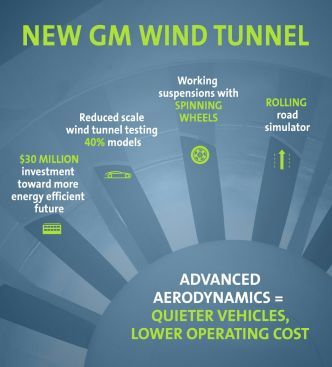New GM Wind Tunnel Accelerates Fuel-Saving Designs
 |
Expanded testing capacity for quieter vehicles and lower operating cost
WARREN, MI -- November 11, 2015: General Motors is now able to accelerate and verify fuel-saving designs earlier in development of new cars and trucks thanks to a new reduced scale wind tunnel test facility on the campus of the company’s Technical Center.
GM’s new, 35,000-square-foot Reduced Scale Wind Tunnel aerodynamically tests clay models up to 40 percent of the scale of a vehicle. It is equipped with a conveyor-style rolling road system that simulates real-world highway driving conditions up to a top speed of 155 mph. Testing reduced-sized vehicles on a simulated road allows GM aerodynamic engineers to reduce wind drag in a full-size vehicle design.
Advanced 3D printing machines create underbodies and engine blocks that are detailed and to scale for the reduced sized clay models. Working suspensions with spinning wheels allow aerodynamic engineers to better examine how airflow affects a vehicle’s underbody while in motion, resulting in quieter cars and trucks that can cost customers less to operate.
The new aerodynamic test facility is located next to GM’s full-scale wind tunnel that has been in operation since 1980. Together, the facilities give GM a competitive advantage in testing capacity and capabilities.
The original full-scale wind tunnel will be upgraded next year with its own full-scale rolling road system and other improvements.
“The combined capabilities of our new reduced-scale and full-scale wind tunnels allow us to reach industry-leading levels of aerodynamic refinement,” said Ken Morris, vice president, GM Global Product Integrity. “We view the new $30 million reduced scale wind tunnel as an investment towards a better, more energy-efficient future.”


